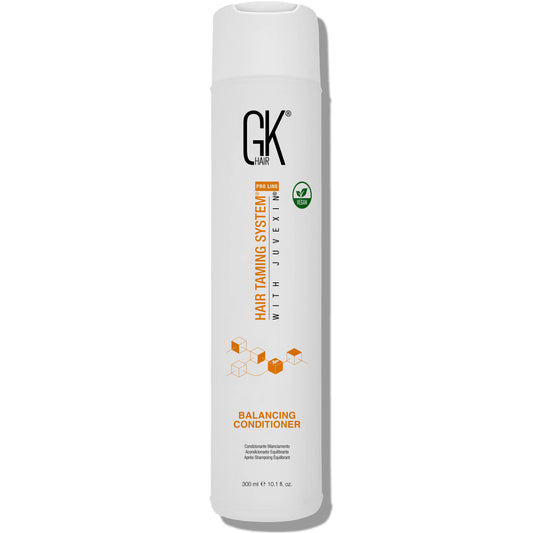Just because you have naturally soft and smooth hair doesn't mean you do not deserve an incredible hair shine and even more softness. Maintaining the shiny, frizz-free, healthy hair is not a walk in the park like you may assume. This is what the balancing conditioner does. It eases your hair into its desired health and eases you of the stress in keeping this going.
Although deep conditioners are more common and great for softening and detangling hair after shampooing, GK Hair Balancing Conditioner does further work in maintaining a stable natural hair pH range of 4.5-5.5. One of the best recommendations by hair specialists is to wash hair slightly before conditioning. However, washing frequently has its demerits. So, you do not have to shampoo your hair before you apply the balancing conditioner for your desired results. Excessively dry or oily hair will lead to frizz, dryness or even damage in no time.
How the Balancing Conditioner Gives Shine and Softness
Most people have recognized the balancing conditioner as their preferred detangling and healthy hair formula for several reasons. For one, it offers more than just shine and softness. GK Hair Balancing Shampoo and Conditioner is rich in ingredients that are sulfate free. Rich in Juvexin V2 and natural seed oils, the conditioner restores hair pH after washing. It is also free of harsh chemicals that react to the color of your hair. Let's consider other benefits of the balancing conditioner over deep conditioner:
Versatility
When you make the decision to Purchase the Balancing Conditioner, you will discover it is a versatile option for any hair type. Since it is free from parabens and sulfate, its formulation keeps Keratin treatments on hair.
Regulates Moisture Level
The balancing conditioner locks in moisture in hair, keeping your hair hydrated and free from frizz. It also seals hair ends, preventing random breakage and unusual splitting. A low hair moisture will cause a strain on hair elasticity, reducing the strength of your hair.
Improves Shine and Softness
Balancing conditioners are a game changer for your hair journey. They are a good choice for greasy hair and great for detangling hair of all textures, color and type.
Balances Hair pH
The natural hair pH should be slightly acidic with a range perfect for keeping the hair cuticle. Otherwise, the hair cuticle constricts, the hair fiber weakens, and the ends become dry and brittle, thus highly prone to breakage. The balancing conditioner does not strip the hair no matter how often it is applied. The trick is to find the right conditioner for you and stick to a routine per style.
Enhances Easy Detangling
Frizz and tangles are one of the major features of natural hair. Many individuals struggle with keeping them in the appropriate balance. From dry scalp and dandruff, to split ends and breakage, the frustration the natural hair brings heightens. With the conditioner, you could salvage the situation effectively! A well conditioned hair screams class and attentiveness to details. Hydrate your hair with the Balancing Conditioner before passing a wide-toothed comb through it.
Reduces Climate Interaction on Hair
The atmosphere is becoming even more toxic than ever. These factors are not limited to pollution, low humidity and UV rays from the sun. There is hardly any remedy to prevent these factors from holding sway. However, you could minimize its impact on your hair with the balancing conditioner that serves as a protective barrier between heat and hair. Every season, you can keep your hair shiny, soft and protected.
How to Make a Great Balancing Conditioner Decision
Now, the choice of conditioner is heavy on you. Your hair type should influence this decision. The conditioner is in variants with slightly unique ingredients to suit all hair types.
Straight hairs: Choose a conditioner specifically designed for straight hair because it contains ingredients that cater to the unique needs of straight hair.
Curly hairs: To protect your hair curls, the right balancing conditioner is one that provides extra moisture and restores sebum, the natural hair oil.
Thick hairs: This hair type requires the Serum Argan Oil for Hair to moisturize hair.
Your hair care routine may require high maintenance if it is the kind that is susceptible to oil and dirt. To get the desired results, the simple hack is to avoid scalp and apply conditioner from top to hair ends. If brushing is a struggle, you could apply mousse or blow dry. Whichever way, you are on the right track to keeping your locks in shape, shine and softness.













Leave a comment